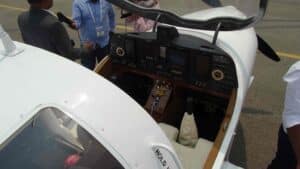Aerospace
Meet the HANSA-NG, a two-seat flying training aircraft developed in India.

- HANSA-NG, India’s first indigenous flying trainer, has successfully completed the sea-level trials
- The aircraft was flown to Puducherry on February 19, in which it covered a distance of 140 nautical miles in 1.5 hours at a cruising speed of 155 km/hr.
HANSA–NG Aircraft designed and developed by CSIR-NAL is major attraction in Wings 2022. HANSA-NG was piloted by Wg. Cdr. Dilip Reddy, an Experimental Test Pilot of IAF. He has demonstrated its flying capabilities like climb, descend, maneuvering, low level stability and short take off /landing, exciting the viewers.
HANSA-NG is one of the most advanced two seat flying trainer aircraft powered by Rotax Digital Control Engine with unique features like Just-In-Time Prepreg (JIPREG) Composite lightweight Airframe, Glass Cockpit, Bubble Canopy with wide panoramic view, electrically operated flaps, etc.
HANSA NG is capable offlying upto an altitude of 10000ft with max speed of 200 kmph with more than 5 hrs endurance. HANSA –NG completed more than 55 hours of flying and will be type certified by DGCA shortly. NAL has already received more than 80 nos. of LoIs (Letter of Intents) from various flying clubs across the country and delivery is scheduled from July 2022.
New Generation aircraft called the HANSA-NG has been developed by incorporating the state-of-the-art technologies and New Generation Design features. It offers advanced digital display systems using certified instruments, two primary flight displays with built in redundant power supply.
The indigenous HANSA-NG will benefit Indian Flying Clubs as well as other customer applications like bird reconnaissance at airfields, cadet training, coastal surveillance, and hobby flying. As a result of this, CSIR-NAL received firm commitments for 10 Nos from M/s Belagavi Aviation Pvt Ltd during Wings India 2022. M/s Blue ray aviation has also shown interest in acquiring 3 nos of the aircraft during the WingsIndia.
World’s first ‘fly and drive car’ ready by 2021
Hansa New Generation, abbreviated as HANSA-NG, India’s first indigenous flying trainer, has successfully completed the sea-level trials as Puducherry from February 19 to March 5. The flying trainer has been designed and developed by the Council of Scientific & Industrial Research (CSIR) – National Aerospace Laboratories (NAL).
The aircraft was flown to Puducherry on February 19, in which it covered a distance of 140 nautical miles in 1.5 hours at a cruising speed of 155 km/hr. Objective Of Trials The sea-level trials were conducted to evaluate handling qualities, climb and cruise performance, balked landing, structural performance, including positive and negative G force, power plant and other systems performance at sea level.
NAL informed in a statement the aircraft achieved all the objectives of the sea-level trials. Later, it was ferried back to Bengaluru on March 5 after completing an 18-hour flying journey from Puducherry.
JM Exclusive tour onboard the EMBRAER E195-E2 Demonstrator.

Aerospace
Boeing Transfers Rocket Stage to NASA, Paving Way for Human Moon Mission

Boeing has achieved a significant milestone by providing NASA with the second core stage of the Space Launch System (SLS) rocket.
This crucial component, crafted at NASA’s Michoud Assembly Facility (MAF), is set to propel the Artemis II crew into lunar orbit, marking humanity’s return to deep space after a 50-year hiatus.
The monumental Boeing-built rocket stage, the largest element of the Artemis II mission, will embark on a journey aboard the Pegasus barge, traveling 900 miles to NASA’s Kennedy Space Center.
Comparison of two legendary aircraft B777x vs B747 aircraft:Click here
Upon arrival, it will be meticulously integrated with other essential Artemis II components, including the upper stage, solid rocket boosters, and NASA’s Orion spacecraft within the iconic Vehicle Assembly Building. This intricate integration process is a vital step toward the eagerly anticipated Artemis II launch, slated for 2025.
“Boeing-built products helped land humankind on the moon in 1969, and we’re proud to continue that legacy through the Artemis generation,” remarked Dave Dutcher, vice president and program manager for Boeing’s SLS program. “Together, with NASA and our industry partners and suppliers, we are building the world’s most capable rocket and paving the way to deep space through America’s rocket factory in New Orleans.”
NASA, Lockheed Martin Reveal X-59 Quiet Supersonic Aircraft:Click here
The delivery of Core Stage 2 marks a significant achievement in the evolution of the SLS rocket. Towering over 200 feet and powered by four RS-25 engines, this core stage, coupled with two solid-fueled booster rockets, will generate a staggering 8.8 million pounds of thrust. This immense power is crucial to launching Artemis II and future missions into the vast expanse of space.
The SLS rocket stands unparalleled in its capability to transport both crew and substantial cargo to the moon and beyond in a single launch. Its extraordinary capacity will facilitate the delivery of human-rated spacecraft, habitats, and scientific missions to destinations including the moon and Mars, ushering in a new era of space exploration.
-

 Travel1 week ago
Travel1 week agoAir India to Expand US Operations with Three New Routes After a Decade
-

 Travel2 weeks ago
Travel2 weeks agoWhy We Should Avoid These Stamps in a Passport
-

 Airlines1 month ago
Airlines1 month agoInvestigations Reveal Fake Chinese Titanium in Boeing and Airbus Jets
-

 Tech4 weeks ago
Tech4 weeks agoChina’s CATL Plans 1,800-Mile Electric Plane Launch by 2027
-

 Airport3 days ago
Airport3 days agoTop 10 Largest Airports in the World by Size
-

 Aerospace4 weeks ago
Aerospace4 weeks agoChina’s Fighter Jets Turn Wings into Autonomous Drones
-

 Airlines4 days ago
Airlines4 days agoAir India Rolls Out A350s for Delhi-New York JFK and Newark Routes
-

 Defence3 weeks ago
Defence3 weeks agoBoeing Enhances Chinook with New Engines and Block II Upgrades at $96 Million








